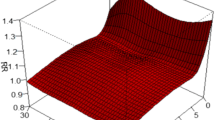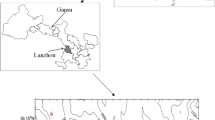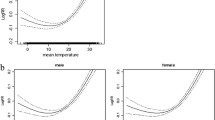Abstract
Extreme temperature is closely associated with human health, but limited evidence is available for the effects of extreme temperatures on respiratory diseases in China. The goal of this study is to evaluate the effects of extreme temperatures on hospital emergency room (ER) visits for respiratory diseases in Beijing, China. We used a distributed lag non-linear model (DLNM) coupled with a generalized additive model (GAM) to estimate the association between extreme temperatures and hospital ER visits for different age and gender subgroups in Beijing from 2009 to 2012. The results showed that the exposure-response curve between temperature and hospital ER visits was almost W-shaped, with increasing relative risks (RRs) at extremely low temperature. In the whole year period, strong acute hot effects were observed, especially for the elders (age > 65 years). The highest RR associated with the extremely high temperature was 1.36 (95% CI, 0.96–1.92) at lag 0–27. The longer-lasting cold effects were found the strongest at lag 0–27 for children (age ≤ 15 years) and the relative risk was 1.96 (95% CI, 1.70–2.26). We also found that females were more susceptible to extreme temperatures than males.





Similar content being viewed by others
References
Anderson BG, Bell ML (2009) Weather-related mortality: how heat, cold, and heat waves affect mortality in the United States. Epidemiology 20:205–213
Bai L, Cirendunzhu, Woodward A, Dawa, Zhaxisangmu, Chen B, Liu QY( 2014) Temperature, hospital admissions and emergency room visits in Lhasa, Tibet: a time-series analysis. Science of the Total Environment. 490, 838–848.
Basu R (2009) High ambient temperature and mortality: a review of epidemiologic studies from 2001 to 2008. Environ Health 8:40
Basu R, Ostro BD (2008) A multicounty analysis identifying the populations vulnerable to mortality associated with high ambient temperature in California. Amer J Epidemiol 168:632–637
Bhaskaran K, Hajat S, Haines A, Herrett E, Wilkinson P (2009) Effects of ambient temperature on the incidence of myocardial infarction. Heart 95(21):1760
Braga AL, Zanobetti A, Schwartz J (2001) The time course of weather-related deaths. Epidemiology 12(6):662–667
Breitner S, Wolf K, Devlin RB, DiazSanchez D, Peters A, Schneider A (2014) Short-term effects of air temperature on mortality and effect modification by air pollution in three cities of Bavaria, Germany: a time-series analysis. Sci Total Environ 485–486(1):49–61
Bunyavanich S, Landrigan CP, McMichael AJ (2003) The impact of climate change on child health. Ambul Pediatr 3:44–52
Curriero FC, Heiner KS, Samet JM, Zeger SL, Strug L, Patz JA (2002) Temperature and mortality in 11 cities of the eastern United States. Am J Epidemiol 155:80–87
Curtis S, Fair A, Wistow J, Val DW, Oven K (2017) Impact of extreme weather events and climate change for health and social care systems. Environ Health, 16(suppl 1), 128: 24–32.
D’Ippoliti D, Michelozzi P, Marino C, De’Donato F, Menne B, Katsouyanni K, Kirchmayer U, Analitis A, Medina-Ramón M, Paldy A (2010) The impact of heat waves on mortality in 9 European cities: results from the EuroHEAT project. Environ Health 9(1):37
Davídkovová H, Plavcová E, Kynˇcl J, Kyselý J (2014) Impacts of hot and cold spells differ for acute and chronic ischaemic heart diseases. BMC Public Health 14(1):480
Diaz J, Garcia R, Velazquez de Castro F, Hernandez E, Lopez C (2002) Effects of extremely hot days on people older than 65 years in Seville (Spain) from 1986 to 1997. Int J Biometeorol 46:145–149
Gasparrini A, Armstrong B, Kenward MG (2010) Distributed lag non-linear models. Stasistics in Medicine 29, 2224–2234.
Goggins WB, Chan EY, Yang C, Chong M (2013) Associations between mortality and meteorological and pollutant variables during the cool season in two Asian cities with sub-tropical climates: Hong Kong and Taipei. Environ Health 12(1):59
Goldberg MS, Gasparrini A, Armstrong B, Valois MF (2011) The short-term influence of temperature on daily mortality in the temperate climate of Montreal, Canada Environmental Research 111(6), 853–860.
Goodman PG, Dockery DW, Clancy L (2004) Cause-specific mortality and the extended effects of particulate pollution and temperature exposure. Environ Health Perspect 112:179–185
Gouveia N, Hajat S, Armstrong B (2003) Socioeconomic differentials in the temperature-mortality relationship in Sao Paulo. Brazil Int J Epidemiol 32:390–397
Guo Y, Barnett AG, Pan X, Yu W, Tong S (2011) The impact of temperature on mortality in Tianjin, China: a case-crossover design with a distributed lag nonlinear model. Environ Health Perspect 119:1719–1725
Guo Y, Li S, Zhang Y, Armstrong B, Jaakkola JJ, Tong S, Pan X (2013) Extremely cold and hot temperatures increase the risk of ischaemic heart disease mortality: epidemiological evidence from China. Heart 99(3):195–203
Guo YM, Punnasiri K, Tong SL (2012) Effect of temperature on mortaltiy in Chiang Mai city, Thailand: a time series study. Environmental Health 11(36):1–9
Hajat S, Kosatsky T (2010) Heat-related mortality: a review and exploration of heterogeneity. J Epidemiol Community Health 64(9):753–760
Hajat S, Kovats RS, Lachowycz K (2007) Heat-related and cold-related deaths in England and Wales: who is at risk? Occup Environ Med 64(2):93–100
Huang CR, Barnett AG, Wang XM, Tong SL (2012) Effects of extreme temperature on years of life lost for cardiovascular deaths: a time series study in Brisbane. Australian Circ Cardiovasc Qual Outcomes:609–614
Huynen MM, Martens P, Schram D (2001) The impact of heat waves and cold spells on mortality rates in the Dutch population. Environ Health Perspect 109:463–470
Iniguez C, Ballester F, Ferrandiz J, Perez-Hoyos S, Saez M, Lopez A (2010) Relation between temperature and mortality in thirteen Spanish cities. Int J Environ Res PublicHealth 7:3196–3210
IPCC (2013) Climate change 2013: the physical science basis. Contribution of Working Group I to the Fifth Assessment Report of the Intergovernmental Panel on Climate Change. [Stocker, T.F., D. Qin, G.-K. Plattner, M. Tignor, S.K. Allen, J. Boschung, A. Nauels, Y. Xia, V. Bex and P.M. Midgley (eds.)]. Cambridge University Press, Cambridge, United Kingdom and New York, NY, USA.
Johnson H, Kovats S, McGregor G, Stedman J, Gibbs M, Walton H (2005) The impact of the 2003 heat wave on daily mortality in England and Wales and the use of rapid weekly mortality estimates. Euro Surveill 10:161–165
Kan HD, London SJ, Chen GH (2008) Season, sex age, and education as modifiers of the effects of outdoor air pollution on daily mortality in Shanghai, China: the Public Health and Air Pollution in Asia (PAPH) study. Environ Health Perspect 116:1183–1188
Kim H, Ha JS, Park J (2006) High temperature, heat index, and mortality in 6 major cities in South Korea. Arch Environ Occup Health 61(6):265–270
Knowlton K, Rotkin-Ellman M, King G, Margolis HG, Smith D, Solomon G et al (2009) The 2006 California heat wave: impacts on hospitalizations and emergency department visits. Environ Health Perspect 117:61–67
Kovats RS, Hajat S (2008) Heat stress and public health: a critical review. Annu Rev Public Health 29(1):41–55
Lin S, Luo M, Walker RJ, Liu X, Hwang SA, Chinery R (2009) Extreme high temperatures and hospital admissions for respiratory and cardiovascular diseases. Epidemiology 20:738–746
Lin YK, Chang CK, Wang YC, Ho TJ (2013) Acute and prolonged adverse effects of temperature on mortality from cardiovascular diseases. PLoS One 8(12):e82678
Luo HJ, Zeng SQ, Hu MJ, Luo Y, Ma WJ (2014) Effect of extreme low temperature on respiratory hospital admissions: a time-series study. South China J Prev Med 40(6):504–511
Ma WJ, Chen RJ, Kan HD (2014) Temperature-related mortality in 17 large Chinese cities: how heat and cold affect mortality in China. Environ Res 134:127–133
Ma W., Zeng W, Zhou M, Wang L, Rutherford S, Lin H, Liu T, Zhang Y, Xiao J ( 2015) The short-term effect of heat waves on mortality and its modifiers in China: an analysis from 66 communities. Environ Int 75, 103–109.
Martin SL, Cakmak S, Hebbern CA, Avramescu ML, Tremblay N (2012) Climate change and future temperature-related mortality in 15 Canadian cities. Int J Biometeorol 56(4):605–619
McMichael AJ, Wilkinson P, Kovats RS, Pattenden S, Hajat S, Armstrong B, Vajanapoom N, Niciu EM, Mahomed H, Kingkeow C (2008) International study of temperature, heat and urban mortality: the “ISOTHURM” project. Int J Epidemiol 37:1121–1131
Medina-Ramón M, Zanobetti A, Cavanagh DP, Schwartz J (2006) Extreme temperatures and mortality: assessing effect modification by personal characteristics and specific cause of death in a multi-city case-only analysis. Environ Health Perspect 114:1331–1336
Michelozzi P, Accetta G, Sario MD, D’Ippoliti D, Marino C, Baccini M, Biggeri A, Anderson HR, Katsouyanni K, Ballester F (2009) High temperature and hospitalizations for cardiovascular and respiratory causes in 12 European cities. Amer J Respir Crit Care Med 179:383–389
Mireku NA (2009) Changes in weather may trigger child’s asthma. Eur Ann Allergy Clin Immunol 160(5):41
Moran A, Gu D, Zhao D, Coxson P, Wang YC (2010) Future cardiovascular disease in China markov model and risk factor scenario projections from the coronary heart disease policy model–China. CircCardiovascQual Out-comes 3(3):243
Muggeo VM, Hajat S (2009) Modelling the non-linear multiple-lag effects of ambient temperature on mortality in Santiago and Palermo: a constrained segmented distributed lag approach. Occup Environ Med 66(9):584–591
O'Neill MS, Ebi KL (2009) Temperature extremes and health: impacts of climate variability and change in the United States. J Occup Environ Med 51:13–25
Qiu H, Tian LW, Ho KF (2015) Air pollution and mortality: effect modification by personal characteristics and specific cause of death in a case-only study. Environ Pollut 199:192–197
Revich B, Shaposhnikov D (2008) Temperature-induced excess mortality in Moscow, Russia. Int JBiometeorol 52:367–374
Rocklöv J, Forsberg B (2008) The effect of temperature on mortality in Stock-holm 1998-2003: a study of lag structures and heatwave effects. Scand J Public Health 36:516–523
Seposo XT, Dang TN, Yasushi H (2015) Evaluating the effects of temperature on mortality in Manila City (Philippines) from 2006–2010 using a distributed lag nonlinear model. Int J Environ Res Public Health 12:6842–6857
Son JY, Lee JY, Anderson GB, Bell ML (2011) Vulnerability to temperature-related mortality in Seoul. Korea Environ Res Lett 6(3):034027
Son JY, Lee JT, Anderson GB, Bell ML (2012) The impact of heat waves on mortality in seven major cities in Korea. Environ Health Perspect 120:566–571
Song XP, Wang SG, Li TS, Tian JH, Ding GW, Wang JX, Wang JX, Shang KZ (2017) The impact of heat waves and cold spells on respiratory emergency department visits in Beijing. China Science of the Total Environment 615:1499–1505
Stafoggia M, Forastiere F, Agostini D, Biggeri A, Bisanti L, Cadum E, Caranci N, De’Donato F (2006) Vulnerability to heat-related mortality: a multicity, population-based, case-crossover analysis. Epidemiology 17:315–323
Stewart S, Ekman I, Ekman T, Odén A, Rosengren A (2010) Population impact of heart failure and the most common forms of cancer a study of 1,162,309 hospital cases in Sweden (1988 to 2004). Circ Cardiovasc Qual Outcomes 3(6):573–580
Tataru N, Vidal C, Decavel P, Berger E, Rumbach L (2006) Limited impact of the summer heat wave in France (2003) on hospital admissions and relapses for multiple sclerosis. Neuroepidemiology 27:28–32
Turner LR, Connell D, Tong SL (2012) Exposure to hot and cold temperatures and ambulance attendances in Brisbane, Australia: a time-series study. BMJ Open 2(4):e001074
VicedoCabrera AM, Iñíguez C, Barona C, Ballester F (2014) Exposure to elevated temperatures and risk of preterm birth in Valencia, Spain. Environ Res 134:210–217
Wang YC, Lin YK, Chuang CY, Li MH, Chou CH, Liao CH, Sung FC (2012) Associating emergency room visits with first and prolonged extreme temperature event in Taiwan: a population-based cohort study. Sci Total Environ 416, 97–104.
Wang CC, Chen RJ, Kuang XY, Duan XL, Kan HD (2014) Temperature and daily mortality in Suzhou, China: a time series analysis. Sci Total Environ 466–467(1):985–990
Wang XY, Li GX, Liu LQ et al (2015) Effect of extreme temperatures on cause-specific cardiovascular mortality in China. International Journal of Environmental Research and Public Health 12:16136–16156
Xiang J, Bi P, Pisaniello D, Hansen A (2014) The impact of heatwaves on workers’ health and safety in Adelaide. South Australia Environ Res 133:90–95
Yang J, Ou CQ, Ding Y, Zhou YX, Chen PY (2012) Daily temperature and mortality: a study of distributed lag non-linear effect and effect modification in Guangzhou. Environ Health 11(1):63
Yang J, Liu HZ, Ou CQ, Lin GZ, Ding Y, Zhou Q et al (2013) Impact of heat wave in 2005 on mortality in Guangzhou. China Biomed Environ Sci 26:647–654
Yi W, Chan AP (2015) Effects of temperature on mortality in Hong Kong: a time series analysis. Int J Biometeorol 59:927–936
Yu W, Hu W, Mengersen K, Guo Y, Pan X, Connell D, Tong S (2011a) Time course of temperature effects on cardiovascular mortality in Brisbane. Australia Heart 97:1089–1093
Yu W, Mengersen K, Hu W, Guo Y, Pan X, Tong S (2011b) Assessing the relationship between global warming and mortality: lag effects of temperature fluctuations by age and mortality categories. Environ Pollut 159:1789–1793
Zanobetti A, Schwartz J, Samoli E, Gryparis A, Touloumi G (2003) The temporal pattern of respiratory and heart disease mortality in response to air pollution. Environ Health Perspect 111(9), 1188–1193.
Zeng W, Lao X, Rutherford S, Xu Y, Xu X, Lin H, Liu T, Luo Y, Xiao J, Hu M (2014) The effect of heat waves on mortality and effect modifiers in four communities of Guangdong province. China Sci Total Environ 482-483(1):214–221
Funding
This work is supported by Fundamental Research Funds for the Central Universities Grant No. lzujbky-2017-69, National Natural Science Foundation of China Grant No. 41475095, No. 91737101, and No. 41561037. Part of the work is funded by a Scholarship awarded to Yuxia Ma (File No.201308625022) supported by the China Scholarship Council (CSC).
Author information
Authors and Affiliations
Corresponding authors
Ethics declarations
Conflict of interest
The authors declare that they have no conflict of interest.
Additional information
Responsible editor: Philippe Garrigues
Electronic supplementary material
ESM 1
(DOC 390 kb)
Rights and permissions
About this article
Cite this article
Ma, Y., Zhou, J., Yang, S. et al. Effects of extreme temperatures on hospital emergency room visits for respiratory diseases in Beijing, China. Environ Sci Pollut Res 26, 3055–3064 (2019). https://doi.org/10.1007/s11356-018-3855-4
Received:
Accepted:
Published:
Issue Date:
DOI: https://doi.org/10.1007/s11356-018-3855-4




